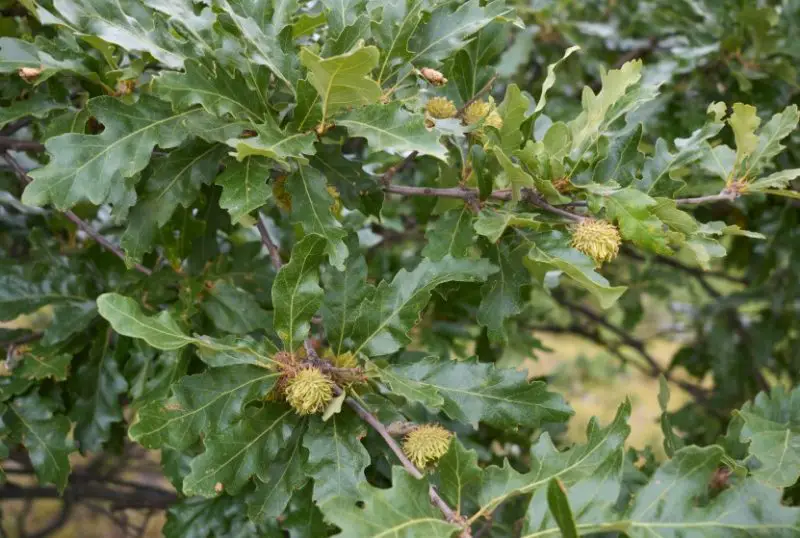Turkey Oak (Quercus cerris) is a majestic deciduous tree native to Southern Europe and Western Asia. It is renowned for its resilience, unique leaves, and distinctive acorns. This tree has been widely cultivated for its ornamental value, timber, and ecological benefits. Turkey Oak is an excellent addition to parks, large gardens, and reforestation efforts due to its rapid growth and adaptability.
In this article, we will explore the characteristics, interesting facts, and essential care tips for growing Turkey Oak successfully. Whether you are a gardening enthusiast or a forestry expert, understanding the traits and requirements of this tree will help you cultivate it effectively.
Characteristics of Turkey Oak

Appearance
Turkey Oak is a medium to large-sized tree that can grow up to 30–40 meters (98–131 feet) in height. It has a broad, rounded crown and a sturdy, thick trunk that provides stability against strong winds. The bark of the Turkey Oak is deeply furrowed and dark gray, giving it a rugged and aged appearance. As the tree matures, the texture of the bark becomes even more pronounced, adding to its visual appeal in landscapes and natural settings.
Leaves
One of the most distinctive features of the Turkey Oak is its deeply lobed, glossy green leaves. These leaves are typically 7–14 cm long and have sharply pointed lobes, resembling the feathers of a turkey—hence the name “Turkey Oak.” The underside of the leaves is slightly hairy, providing a unique texture. In autumn, the foliage turns a range of colors, from yellow to golden brown, before eventually shedding in winter. This seasonal transformation enhances the tree’s beauty throughout the year, making it a valuable addition to any landscape.
Flowers and Fruits
Turkey Oak produces small, inconspicuous yellowish-green catkins in the spring, which are wind-pollinated. These catkins play a crucial role in the reproductive cycle of the tree, facilitating pollination and acorn production. The tree also bears acorns that are enclosed in a distinctive, hairy cup covered in bristles. Unlike some other oak species whose acorns mature within a single season, Turkey Oak acorns take about 18 months to fully develop. This extended maturation period ensures that the acorns are well-prepared to germinate in the following season.
Growth Rate and Lifespan
Turkey Oak is known for its relatively fast growth rate compared to other oak species. It can grow approximately 30–60 cm per year, making it an excellent choice for reforestation projects and landscaping. Under ideal conditions, Turkey Oak can live for over 150 years, providing shade, oxygen, and habitat for wildlife for many generations. Due to its longevity, the tree has been historically valued for both its aesthetic appeal and practical uses.
Fascinating Facts About Turkey Oak
Historical Significance
Turkey Oak has been used historically for timber, fuelwood, and construction. Although its wood is not as prized as other oak species like Quercus robur, it remains an important tree in European forestry. In the past, the durable wood of the Turkey Oak was used for railway sleepers, furniture, and firewood, making it an essential resource in many regions. Its presence in forests has contributed to economic activities related to timber production and land management.
Adaptability
One of the key reasons for Turkey Oak’s widespread cultivation is its high adaptability. This tree thrives in a variety of soil types, including sandy, clay, and loamy soils. It is highly drought-tolerant and can withstand prolonged dry periods, making it ideal for regions with irregular rainfall patterns. Additionally, Turkey Oak can endure moderate frost, allowing it to grow in both temperate and subtropical climates. Its ability to thrive in poor soil conditions makes it a resilient choice for areas prone to environmental stress.
Ecological Role
Turkey Oak serves as a crucial habitat for numerous wildlife species. Its acorns provide a valuable food source for birds, squirrels, and deer. The tree’s dense foliage and sturdy branches offer nesting sites and shelter for various animals, promoting biodiversity in forests and green spaces. Furthermore, Turkey Oak plays a role in soil stabilization, helping to prevent erosion in hilly and sloped terrains. By supporting a diverse ecosystem, this tree contributes significantly to environmental sustainability.
Invasive Potential
In some regions, Turkey Oak is considered an invasive species because of its ability to spread rapidly and outcompete native vegetation. Its fast growth and prolific acorn production enable it to establish itself in new environments quickly. This can lead to the displacement of native plant species and alter local ecosystems. In areas where Turkey Oak is not indigenous, careful management is required to prevent uncontrolled expansion and maintain ecological balance.
Care Tips for Growing Turkey Oak
Soil Requirements
Turkey Oak prefers well-drained soils but is highly adaptable to various soil conditions, including poor and rocky soils. However, for optimal growth, it is best to plant it in fertile, loamy soil with good drainage. Ensuring the soil has adequate nutrients will promote healthy root development and vigorous growth.
Sunlight and Location
This tree thrives in full sunlight and requires at least 6 hours of direct sun per day. It is best to plant Turkey Oak in an open space where it can grow freely without competition from other large trees. When selecting a location, consider areas with ample room for expansion, as this tree can grow quite large over time.
Watering Needs
Once established, Turkey Oak is highly drought-tolerant and requires minimal watering. However, young trees should be watered regularly during the first few years to ensure strong root development. Providing adequate moisture in the early stages will help the tree establish itself more effectively.
Pruning and Maintenance
Pruning is essential to maintain the health and shape of the tree. Remove dead, diseased, or damaged branches in late winter or early spring before new growth begins. Avoid excessive pruning, as this can stress the tree. Occasional trimming can also help improve air circulation and overall tree structure.
Pest and Disease Management
Turkey Oak is relatively resistant to most pests and diseases but can occasionally suffer from oak mildew, aphid infestations, and fungal infections. Regular inspection and proper care can help prevent major issues. If necessary, use organic pesticides or natural predators to manage pests without harming the environment.
Fertilization
While Turkey Oak does not require frequent fertilization, applying a balanced fertilizer in early spring can promote healthy growth, especially in nutrient-poor soils. Organic compost or slow-release fertilizers are excellent choices to enhance soil fertility naturally.
Propagation
Turkey Oak can be propagated from acorns. Collect mature acorns in autumn, stratify them in moist soil for several months, and then plant them in well-prepared soil. Seedlings typically emerge in spring and require proper care until they establish strong roots. This method ensures genetic diversity and allows for the sustainable expansion of Turkey Oak populations.
Conclusion
Turkey Oak is a versatile and resilient tree that offers numerous benefits for the environment and landscaping. With its unique appearance, adaptability, and low maintenance requirements, it is an excellent choice for parks, gardens, and reforestation projects. By following the care tips outlined in this guide, you can successfully grow and maintain a healthy Turkey Oak tree for generations to come.






